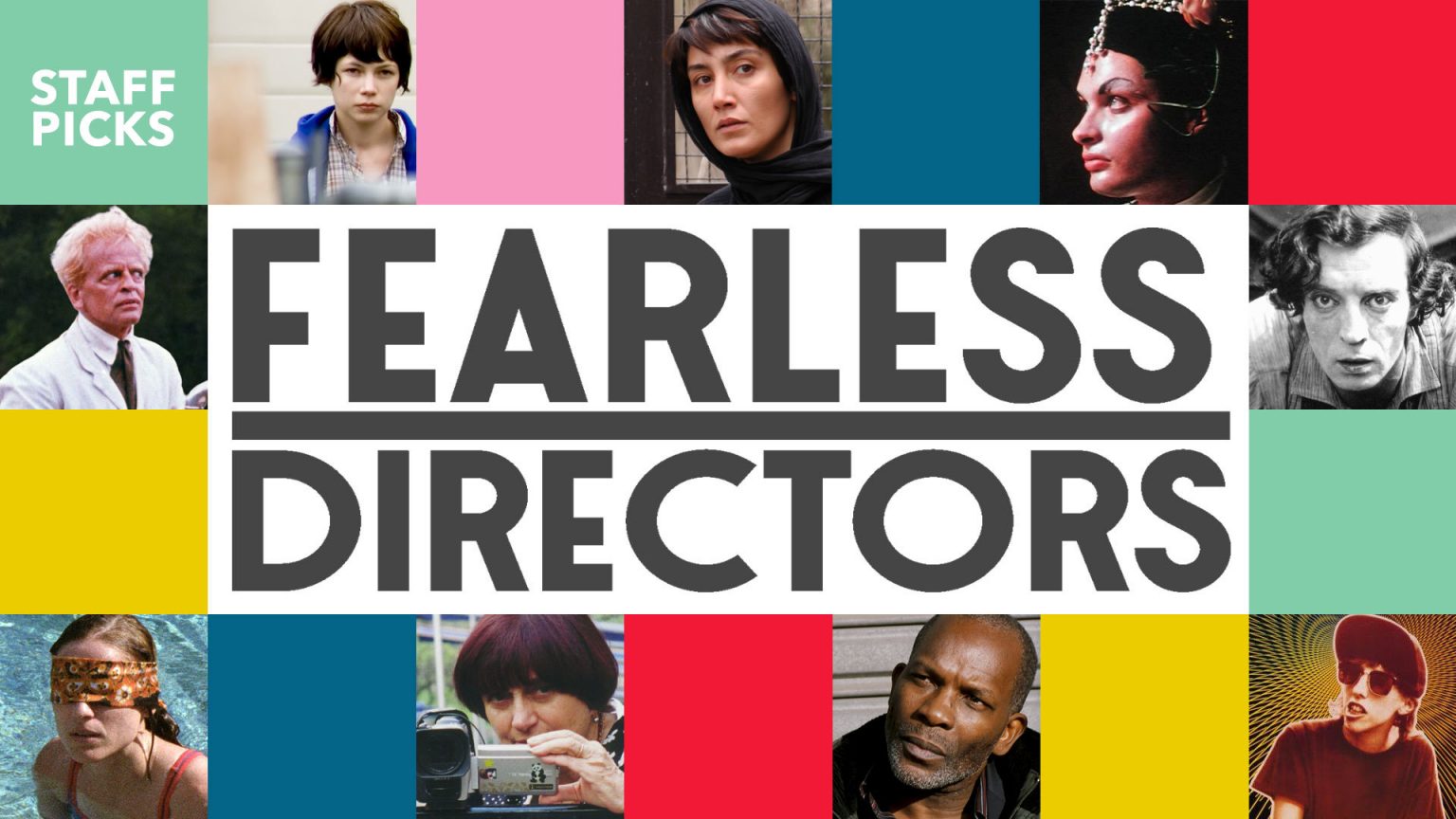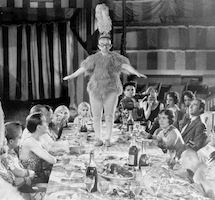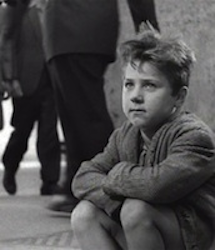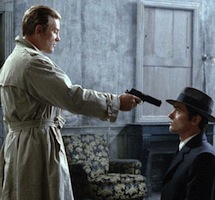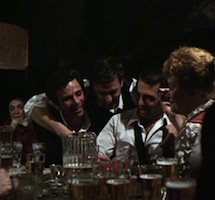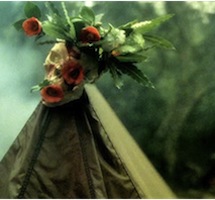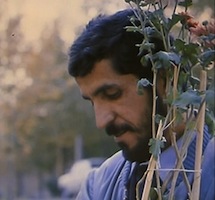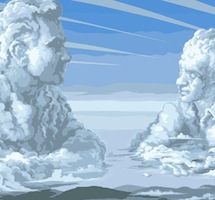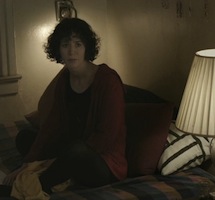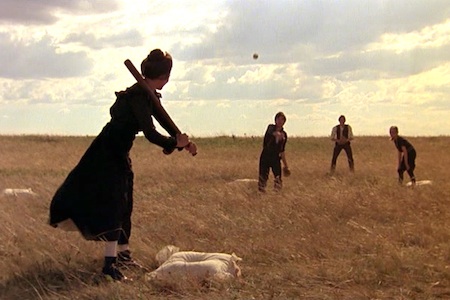
I would like to apologize to the other ten thousand mind-blowing films I wasn’t able to include, as I’m sure that if I had seen more films, the list of my 100 favorites would be different. But I can safely say that each of these films blew me away and stayed with me long after it ended. And, yes, reducing each of them to a single sentence feels like an act of sacrilege, but that is the task I was given. And so I present The Caveh Zahedi 100.
1. Sherlock Jr. (Buster Keaton, 1924) The first self-reflexive film masterpiece is so pregnant with ideas that it later gave birth to both Maya Deren’s At Land and Woody Allen’s The Purple Rose of Cairo.
2. The Circus (Charlie Chaplin, 1928) Chaplin’s oft-neglected gem boasts two of the funniest scenes in his formidably funny oeuvre: Chaplin on a tightrope besieged by a congress of monkeys and Chaplin in a sleeping lion’s cage trying to quiet a barking dog.
3. Freaks (Tod Browning, 1932) A midget who falls in love with a tall woman while his midget girlfriend watches powerlessly from the sidelines is a perfect visual correlative for wanting the impossible in this heartbreaking and utterly original blend of naturalism and horror.
4. It’s a Wonderful Life (Frank Capra, 1946) Capra’s Nietzschean affirmation of life rivals Dante’s Inferno for the dark journey Jimmy Stewart must undertake to overcome the temptation of suicide and come to terms with life’s disappointments.
5. Bicycle Thieves (Vittorio De Sica, 1948) This neorealist contender for the greatest film of all time boasts a brilliantly minimalist screenplay (by Cesare Zavatinni) and the inspired casting of a non-actor whose tragedy-inflected face becomes the perfect embodiment of post-war Italy.
6. Umberto D. (Vittorio de Sica, 1952) The scene in which Umberto D., reduced to having to beg on the street, pretends to be checking for raindrops in order to save face is the cinema’s most perfect dramatization of the complex dialectic between humility and humiliation.
7. Tokyo Story (Yasujiro Ozu, 1953) Wim Wenders’ favorite film by the zen master of cinema builds slowly but achieves subtleties of human interaction that continue to resonate for a lifetime.
8. Les Maitres Fous (Jean Rouch, 1955) This ethnographic documentary about a group of African workers who get together on weekends, kill a chicken, go into ecstatic trance, foam at the mouth and reenact primal scenes from the collective unconscious needs to be seen to be believed.
9. Nights of Cabiria (Federico Fellini, 1957) The look on Giulietta Masina’s face after her trust has been betrayed once again is as unforgettable as her slowly dawning smile at the end.
10. Vertigo (Alfred Hitchcock, 1958) Hitchcock’s greatest film transcends the crime genre to attain almost Shakespearian proportions.
11. The 400 Blows (Francois Truffaut, 1959) Truffaut takes the invaluable neo-realist lessons learned during his tutelage with André Bazin and then Roberto Rossellini, adds a dash of French panache, and voilà: the clarion call and perfect embodiment of the French New Wave.
12. Pickpocket (Robert Bresson, 1959) Bresson’s experiment in cinematic restraint miraculously captures the high of stealing as well as its justification in this haunting adaptation of the memoirs of a real-life pickpocket.
13. Late Autumn (Yasujiro Ozu, 1960) Ozu’s quiet story of an aging widower gently trying to persuade his dutiful daughter to get married and live her own life before it is too late is heart-breaking for the self-sacrifice expressed by all concerned.
14. The Naked Island (Kaneto Shindo, 1960) This wordless film about a farmer couple struggling to make ends meet on a Japanese Island uses sound to astonishing effect.
15. Last Year at Marienbad (Alain Raisnais, 1961) Alternately maddening and sublime, there has never been another film like it. This is the film that God intended when He invented the art of cinema.
16. La Jetée (Chris Marker, 1962) Marker’s time-travel photomontage impresses by the simultaneous brilliance of its narrative, the bold originality of its form and the staggering economy of its means.
17. Vivre Sa Vie (Jean-Luc Godard, 1962) Godard’s masterful audio-visual essay on the art of mise-en-scene takes a time-out just to listen to a song on the jukebox.
18. 8 1/2 (Federico Fellini, 1963) Has anyone ever better captured the dream state?
19. The Fire Within (Louis Malle, 1963) Malle’s devastating adaptation of Drieu La Rochelle’s novel about a man’s attempts to say goodbye to the people he loves before taking his own life is plangent with inexpressible sorrow.
‘The Future:’ I don’t understand why July’s astonishingly original meditation on love and death wasn’t immediately and universally recognized as the masterpiece that it is.
20. Andrei Roublev (Andrei Tarkovsky, 1966) The scene with the bell is so movingly sublime that even just telling the story in words invariably moves me to tears.
21. Unsere Afrikareise (Peter Kubelka, 1966) Several years in the making using only scissors and glue, this short masterpiece of editing density has been a huge influence on yours truly.
22. Mouchette (Robert Bresson, 1967) The master of understatement’s weird ending, in which Mouchette’s rolling game transitions effortlessly into suicide, is the ultimate lesson in how to say more by saying less.
23. Report (Bruce Conner, 1967) Using the Zapruder film to startling effect, Conner creates one of the cinema’s most perfect blend of form and content in this experimental found footage film ostensibly about the Kennedy assassination but really about our own mortality.
24. The Samurai (Jean-Pierre Melville, 1967) The progenitor of the French New Wave shows the way by transmuting the B-movie crime film into metaphysical poetry.
25. The Passion of Anna (Ingmar Bergman, 1969) Bergman interrupts his narrative four times to interview each of the film’s four main actors about the character they’re playing in this bold and fascinating experiment in Brechtian self-reflexivity.
26. Dodes Kaden (Akira Kurosawa, 1970) Kurosawa’s heartfelt series of interconnected vignettes about the disenfranchised poor also contains an unforgettably poignant portrait of artistic potentiality unfulfilled.
27. Husbands (John Cassavetes, 1970) Has there ever been a more honest, more self-accepting, and more loving filmmaker?
28. The Man Who Left His Will on Film (Nagisa Oshima, 1970) Oshima’s elegaic allegory about the futility of political activism strikes an exquisite blend of clarity and enigma.
29. Family Life (Ken Loach, 1971) This R.D. Laing-inflected (and now largely discredited) early seventies argument that it’s our social institutions that make people crazy nevertheless resonates with heart-breaking truth.
30. Minnie and Moskowitz (John Cassavetes, 1971) The romantic comedy genre is turned on its head in this disarmingly honest exploration of how difficult it is for any two people to get along.
31. Walkabout (Nicholas Roeg, 1971) Ex-cinematographer Roeg’s baroque visual style and career-long preoccupation with the themes of Freud’s Civilization and its Discontents finds its perfect embodiment in this aboriginal culture clash road movie set in the Australian outback.
32. Badlands (Terence Malick, 1973) This true crime story’s mix of realism, poetry, and metaphysics has never been surpassed. It blows me away every time I watch it.
33. The Mother and the Whore (Jean Eustache, 1973) Jean-Pierre Léaud gives his single greatest performance as Eustache’s alter ego in this relentless exploration of the mother/whore complex.
34. The Spirit of the Beehive (Victor Errice, 1973) Errice’s subtle political allegory is also one of the best films ever made about childhood’s porous boundary between reality and fantasy.
35. Celine and Julie Go Boating (Jacques Rivette, 1974) Rivette’s playful yet spooky dramatization of Nietzsche’s idea of the Eternal Return successfully marries the French New Wave’s cinema of everyday life with the supernatural thriller genre.
36. A Woman Under the Influence (John Cassavetes, 1974) I think this is my favorite film of all time.
37. Kings of the Road (Wim Wenders, 1976) Wenders’ career-long obsession with lives briefly intersecting and then going their separate ways here finds its fullest and most iconic expression.
38. Mickey and Nicky (Elaine May, 1976) This tour de force performance by real-life friends John Cassavetes and Peter Falk explores the unspoken complexities of male friendship with the wildly elegant precision of tightrope-walking clowns.
39. The Devil Probably (Robert Bresson, 1977) Bresson’s indictment of environmental destruction contains one of the most brilliant endings in the history of cinema.
40. Eraserhead (David Lynch, 1977) Heidegger’s concept of being’s self-erasure finds here its perfect cinematic expression.
41. Opening Night (John Cassavetes, 1977) Cassavetes channels The Exorcist and knocks it out of the park yet again in this mystical love letter to the theater.
42. Days of Heaven (Terence Malick, 1978) The Rimbaud of American Cinema brilliantly modernizes a Biblical story, swarm of locusts and all. I first saw this film while seated on the floor in the center aisle of a church and felt that the film had been made just for me.
43. Perceval Le Gallois (Eric Rohmer, 1978) Rohmer opens up a whole field of cinematic possibilities (still untapped) with this stunningly bold and visually sublime Medieval love letter in verse.
44. Vertical Features Remake (Peter Greenaway, 1978) Greenaway’s self-reflexive mindfuck of a film takes the metaphysical literary tradition of Borges and Calvino and weds it to the Structuralist film genre.
45. Hypothesis of the Stolen Painting (Raul Ruiz, 1979) The brilliant Chilean director’s innovative adaptation of Pierre Klossowski’s novel utilizes the tableau vivant to unprecedented effect.
46. Stalker (Andrei Tarkovsky, 1979) The cinema’s most spiritually evolved director slow tracks his way through a nuclear radiation Zone where people’s deepest wishes come true, even the ones they didn’t know they had.
47. The Territory (Raúl Ruiz, 1981) Ruiz’s metaphysical companion piece to Wim Wenders’ The State of Things tells a primal story of modern-day cannibalism by way of a Godardian aesthetic that Ruiz makes entirely his own.
48. Diaries (Ed Pincus, 1982) Pincus’s astonishingly moving diary film shows the director meeting his future wife, getting married, having children and getting divorced. By distilling time in this way, the tragic strangeness of reality becomes visible and ultimately hits home like a sledge hammer.
49. L’Argent (Robert Bresson, 1983) Pessimist extraordinaire Robet Bresson’s modernization of Tolstoy’s The Forged Coupon shows him at his most austere and unflinching in the face of mankind’s moral deficiencies.
50. Standard Gauge (Morgan Fisher, 1984) Fisher’s paean to the invisible foot soldiers of cinema, projectionists, is a unique and fascinating blend of personal documentary, structuralist cinema and cinematic self-reflexivity
51. Blue Velvet (David Lynch, 1986) I watched Lynch’s bold and honest attempt to grapple with human sexuality on the day the film opened. It was one of the most intense viewing experiences of my life as well as one of the most healing.
52. The Green Ray (Eric Rohmer, 1986) Rohmer’s study of romantic loneliness delights with its mystical surprise ending.
53. Sherman’s March (Ross McElwee, 1986) McElwee single-handedly popularized the personal documentary genre with this subtly poetic and conceptually elegant allegory of the civil war.
54. Street of Crocodiles (Stephen and Timothy Quay, 1986) The art of cinema had only rarely managed to equal the other arts—literature, music, and painting—until the Brothers Quay came along.
55. Two Friends (Jane Campion, 1986) This formally innovative story of friendship told backwards is a poignant meditation on youthful aspirations unfulfilled.
56. Christine (Alan Clarke, 1987) This handheld tracking shot tour de force about an ordinary day in the life of a drug dealer unsettles both formally and thematically.
57. Missile (Frederick Wiseman, 1987) The master of cinema vérité’s quietly observant documentary about a military school where students are taught when and how to press the button that will unleash nuclear war is chilling in its understatement.
58. The Thin Blue Line (Errol Morris, 1988) Morris reinvents and reinvigorates the documentary genre by adding a heaping spoonful of fiction.
59. Chameleon Street (Wendell Harris, 1989) Writer, director, and star Wendell Harris’ overlooked true-story about an African American con artist who successfully impersonated reporters, lawyers, athletes, and surgeons, going so far as to perform more than 36 successful hysterectomies, becomes an eloquent treatise on the psychological costs of racism.
60. Kitchen Sink (Alison Maclean, 1989) This short allegory about the sex act perfectly mixes suspense, the grotesque, and the uncanny.
61. Pièce Touchée (Martin Arnold, 1989) Arnold’s first found-footage masterpiece hypnotizes slowly and then blows one’s mind.
62. Begotten (Elias Merhige, 1990) This mirage of a film was one of the great filmgoing experiences of my life. It invents its own cinematic language with which to communicate the ineffable.
63. Close-Up (Abbas Kiarostami, 1990) This perfect blend of documentary and re-enactment is the crowning achievement of the Iranian New Wave.
64. Short of Breath (Jay Rosenblatt, 1990) This short found-footage experimental masterpiece expresses the ineffability of grief more effectively than any narrative film I can think of.
65. Cabeza de Vaca (Nicolás Echeverría, 1991) This Mexican historical drama about pre-conquest Native American mysticism is the perfect antidote to the Hollywood portrayal of “Indians.”
66. The Double Life of Veronique (Krzysztof Kieślowski, 1991) Jean-Luc Godard once dismissed Kieślowski’s aesthetic as “designer mysticism” but The Double Life of Veronique manages to be both irreducibly mystical and inexplicably accessible and Godard would do well to learn from him.
67. Intimate Stranger (Alan Berliner, 1991) Berliner’s innovative formal strategies raise the documentary genre out of its current social issue ghetto.
68. Van Gogh (Maurice Pialat, 1991) This film made me rethink my prefab view of Van Gogh—no easy feat—and feel like I was discovering him for the first time.
‘It’s a Wonderful Life:’ Capra’s Nietzschean affirmation of life rivals ‘Dante’s Inferno’ for the dark journey Jimmy Stewart must undertake to overcome the temptation of suicide and come to terms with life’s disappointments.
69. Wax, or the Discovery of Television Among the Bees (David Blair, 1991) This brilliant experimental allegory about the first Iraq war is an anti-war film that somehow manages to be utterly non-moralistic. It is so startlingly original that I was inspired to track down the filmmaker and meet him for lunch.
70. The Story of Qiu Ju (Zhang Yimou, 1992) Yimou’s low-key masterpiece is a quietly eloquent demonstration of the folly of revenge and the necessity of forgiveness.
71. A Tale of Winter (Eric Rohmer, 1992) Rohmer’s late-career meditation on the age-old problem of how to tell the difference between “settling” and “accepting what is” also boasts one of the great surprise endings in the history of cinema. I think about this film all the time.
72. 32 Short Films About Glenn Gould (Francois Girard, 1993) The narrative structure of this film proves once and for all that classical Hollywood screenplay structure is only one of many ways to effectively structure a film.
73. Groundhog Day (Harold Ramis, 1993) I taught a whole semester-long class devoted to this film and it still held up!
74. Naked (Mike Leigh, 1993) Leigh’s masterpiece crackles with explosive and uncontainable energy. Seeing it was like having the scales fall off my eyes.
75. Ladybird, Ladybird (Ken Loach, 1994) I worship Ken Loach and love almost all of his films, but this devastating portrait of a mother trying to regain custody of her children is my personal favorite.
76. Salaam Cinema (Mohsen Makhmalbaf, 1995) Makhmalbaf’s hilariously sadistic documentary love poem to cinema does more to undo stereotypes about contemporary Iran than any other film I can think of.
77. Breaking the Waves (Lars von Trier, 1996) This was perhaps the greatest viewing experience of my life. It was like watching, shot for shot, the film that I myself would have been made had I been a more accomplished and more brilliant filmmaker.
78. Gummo (Harmony Korine, 1997) This experimental narrative collage film is pure poetry—bold, beautiful, heart-rending, fearless.
79. The Idiots (Lars von Trier, 1998) The comic despair in the metaphor of one’s inner idiot is very, very close to my heart.
80. Late Marriage (Dover Kosashvili, 2001) This Israeli masterpiece contains my favorite sex scene and helped me to understand why peace has been so elusive in the Middle East.
81. Lilya 4-Ever (Lukas Moodyson, 2001) Watching this film is like being kicked in the heart over and over again. I can’t recommend it highly enough.
82. Waking Life (Richard Linklater, 2001) There has never been anything quite like this one-of-a-kind animated dream of a film.
83. Dogville (Lars von Trier, 2003) Replacing sets with chalk outlines on a sound stage actually works!
84. The Five Obstructions (Lars von Trier, Jorgen Leth, 2003) Von Trier kills off the author (and teacher) and immortalizes him at the same time.
85. Sunset Story (Laura Gabbert, 2003) I’ve never seen a film more effective at ripping away the veil of denial that all of us—including me!—are destined to grow old and die than this unflinching documentary about an old age home for leftists.
86. Wasp (Andrea Arnold, 2003) Arnold’s short masterpiece of kitchen sink realism quietly and gradually stuns without fanfare or pyrotechnics—just the most assured use of the medium imaginable.
87. Eternal Sunshine of the Spotless Mind (Michel Gondry, 2004) A film this original, this brilliantly directed, and this fun strikes a perfect balance between art and commerce.
88. Primer (Shane Carruth, 2004) This film made no money but blew my mind.
89. Tropical Malady (Apichatpong Weerasethakul, 2004) God knows what this film means but one feels oneself in the hands of a true artist.
90. Caché (Michael Haneke, 2005) Haneke’s riff on Lynch’s Lost Highway puzzles and then stuns.
91. Grizzly Man (Werner Herzog, 2005) The scene in which Herzog listens to the audio recording of Timothy Treadwell being eaten by a bear through headphones and then advises the owner of the tape to destroy it without listening to it brilliantly demonstrates that cinema is the art of holding back.
92. The New World (Terrence Malick, 2005) Never have I seen a more persuasive or more unexpected depiction of what the early settlers’ confrontation with Native American culture must have been like.
93. Phantom Limb (Jay Rosenblatt, 2005) The master of grief’s found-footage meditation on the loss of a loved one plumbs even deeper than his previous work.
94. The Puffy Chair (Duplass Brothers, 2005) This comic exploration of romantic attachment by real-life couple Mark Duplass and Katie Aselton reminds me of the Diane Arbus quote: “It’s what I’ve never seen before that I recognize.”
95. Red Road (Andrea Arnold, 2006) Arnold’s gutsy and unflinching exploration of surveillance and revenge at once terrifies, surprises, and disarms.
96. Synecdoche, New York (Charlie Kaufman, 2008) The greatest screenwriter in the history of cinema directs the greatest script in the history of cinema.
97. The Darkness of Day (Jay Rosenblatt, 2009) Rosenblatt’s emotionally harrowing exploration of suicide makes me sob every time I see it.
98. Impaled (Larry Clark, 2010) This short masterpiece from the otherwise mediocre feature-length omnibus film Destricted is hands-down my favorite documentary of all time.
99. The Future (Miranda July, 2011) I don’t understand why July’s astonishingly original meditation on love and death wasn’t immediately and universally recognized as the masterpiece that it is.
100. Life in a Day (Kevin MacDonald, 2011) I was initially skeptical about this crowdsourced documentary edited together from 80,000 submissions and 4,500 hours of footage from 192 countries, all shot on the same day—until I saw it. Wow.
The Sheik and I and other Caveh Zahedi films are streaming on Fandor.

